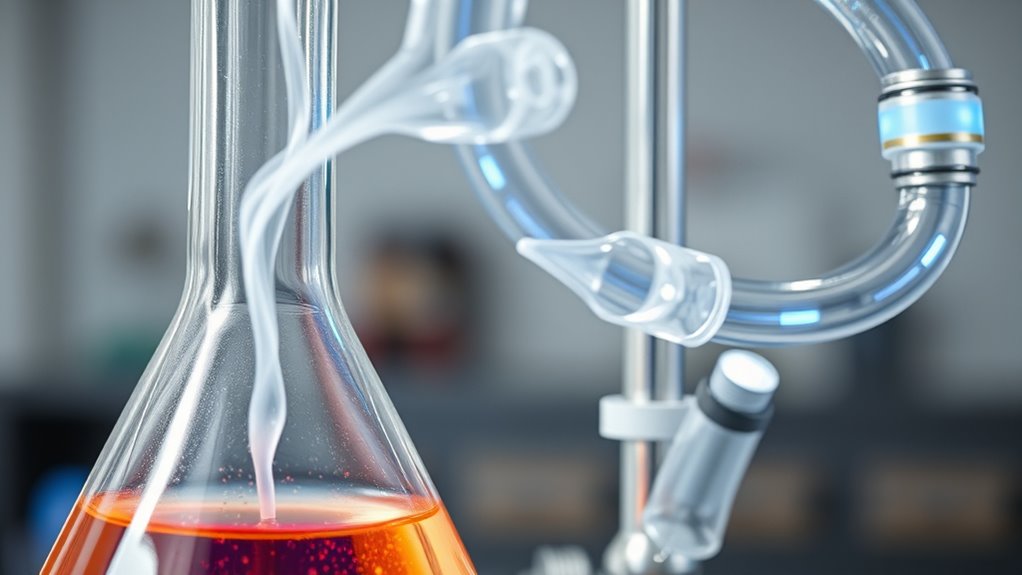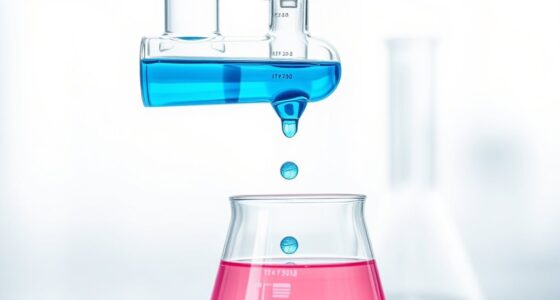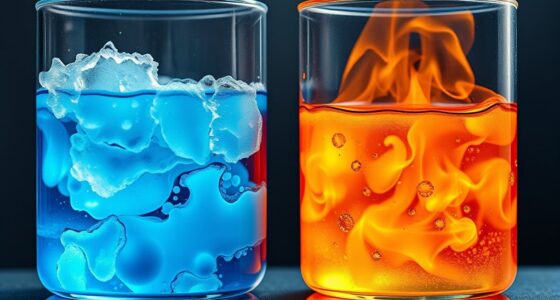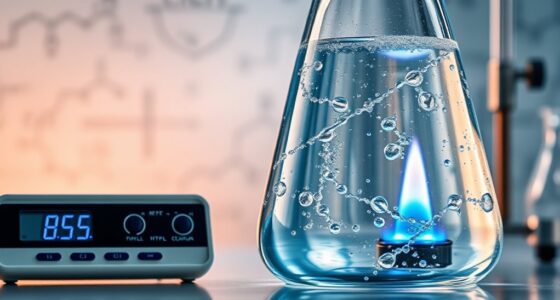Distillation works by heating a mixture so that the component with the lowest boiling point vaporizes first, then collects as a separate liquid. You control the temperature to focus on specific parts, and vapor rises through a still before cooling down into liquid in a condenser. Different distillation methods suit various mixtures, and understanding the chemistry helps optimize the process. If you want to explore more details, you’ll find how these principles apply in real-world applications.
Key Takeaways
- Distillation separates mixtures based on differences in boiling points of components.
- Heating causes low boiling point substances to vaporize first, leaving higher boiling point components behind.
- Vapor rises through the still, then cools and condenses into liquid in the condenser.
- The process can be repeated or refined with fractional distillation for closer boiling points.
- Equipment like distillation columns and condensers facilitate efficient separation of mixture components.
The Basic Principles Behind Distillation
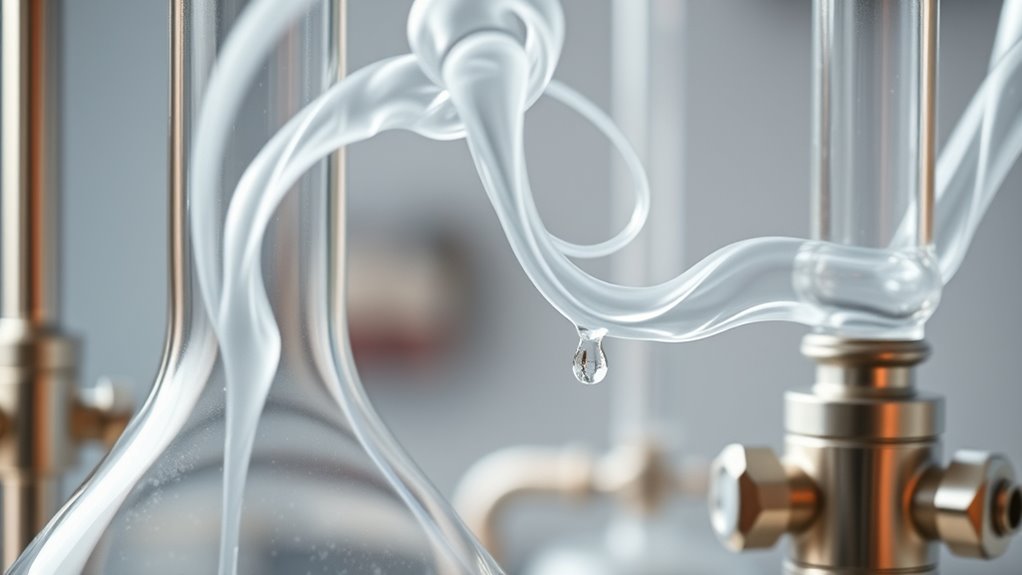
Distillation works by leveraging the differences in boiling points of mixture components. When you heat the mixture, the substance with the lower boiling point vaporizes first, thanks to its higher vapor pressure. As vapor forms, it rises through the still, leaving behind less volatile components. This process is based on the principle that different substances have unique vapor pressures at given temperatures. Boiling occurs when vapor pressure equals atmospheric pressure, enabling separation. Keep in mind, small differences in boiling points can make separation more difficult, especially with substances like alcohol and water that form azeotropes. The process relies on monitoring temperature to ensure proper vaporization. Effective temperature control is essential for selectively vaporizing specific components.
The Step-by-Step Process of Separating Mixtures

Have you ever wondered how mixtures are separated into their individual components? The process begins by heating the mixture gradually, raising its temperature so that the component with the lowest boiling point vaporizes first. Carefully controlling the temperature guarantees you vaporize only the desired part. Gold miners in the late 1840s used panning to find gold. As vapor forms, it mainly contains the most volatile component and rises toward the condenser. In the condenser, the vapor cools and turns back into liquid, which you collect as the distillate. The remaining mixture, with higher boiling points, stays behind. If needed, you can repeat this process or use techniques like fractional distillation for closer boiling points. Distillation is a fundamental method used in many industries to purify chemicals and separate complex mixtures. This step-by-step method efficiently separates components based on their boiling points, allowing you to isolate pure substances.
How Chemical Properties Influence Distillation

Chemical properties such as boiling points, vapor pressures, and intermolecular forces play an essential role in how effectively a mixture can be separated through distillation. You’ll notice that compounds with lower boiling points vaporize first, making it easier to separate them from higher boiling point substances. Vapor pressure indicates how readily a compound turns into vapor; higher vapor pressures mean easier distillation at a given temperature. Intermolecular forces also matter—weak forces make compounds more volatile and simpler to vaporize. However, some mixtures form azeotropes, which have constant boiling points and resist separation via distillation. Additionally, solubility influences the process, affecting how components behave during vaporization and condensation. Understanding these properties helps optimize separation efficiency and predict how mixtures will behave during distillation. Intermolecular forces significantly impact the volatility of compounds, influencing their behavior during distillation.
Different Types of Distillation Techniques

Different distillation techniques are tailored to specific mixtures and separation goals. If your components have widely different boiling points, simple distillation works well, heating the mixture and condensing the vapor. Proper priming ensures smooth operation in some distillation setups, preventing blockages and ensuring efficient separation. For closer boiling points, fractional distillation is more effective, using a fractionating column for multiple vaporization and condensation cycles to improve separation. When dealing with heat-sensitive compounds, steam distillation allows you to extract volatile substances at lower temperatures, ideal for essential oils. Vacuum distillation reduces pressure to lower boiling points, preventing decomposition of high-boiling or unstable substances. Short path distillation minimizes heat exposure and surface contact, perfect for purifying small, sensitive samples.
Practical Applications and Modern Equipment in Distillation

Modern distillation equipment plays a vital role in various industries by enabling efficient and precise separation of mixtures. You’ll find distillation columns at the heart of processes like alcohol production, pharmaceuticals, and chemical manufacturing, where they facilitate continuous or batch separation through vapor-liquid contact.
Reboilers supply heat, vaporizing the mixture, while condensers cool vapors back into liquids for product recovery. Feed tanks and pumps ensure consistent feed delivery, and heat exchangers improve energy efficiency. Additionally, innovations inspired by Honda Tuning modifications have led to more customizable and adaptable distillation systems, allowing for tailored separation processes.
Advanced automation, with sensors and control systems, optimize temperature, pressure, and flow, maintaining product quality. Hybrid stills combine traditional and modern features, offering versatility for flavor retention or purity.
These sophisticated systems support large-scale industrial operations and laboratory applications like solvent recovery, making distillation highly adaptable across sectors.
Frequently Asked Questions
Can Distillation Separate Non-Volatile Substances From Liquids?
You can’t separate non-volatile substances from liquids through distillation because they don’t vaporize at boiling temperatures. During distillation, only the volatile components turn into vapor and are condensed back into liquid, leaving non-volatile impurities behind.
How Does Pressure Affect the Distillation Process?
You see, pressure plays a crucial role in distillation. Lowering pressure reduces boiling points, making it easier to separate components, especially heat-sensitive ones. It also enhances separation efficiency by increasing relative volatility.
Conversely, higher pressure can raise boiling points and allow for higher reflux rates, but may require taller columns and increase energy costs. Adjusting pressure carefully optimizes the process, improves separation, and helps prevent operational issues like flooding.
What Factors Influence the Efficiency of a Distillation Column?
You can improve your distillation efficiency by managing several key factors. Keep the feed mixture uniform and balanced, avoiding too high or low flow rates.
Control operating pressure and temperature precisely to optimize vapor-liquid equilibrium.
Design your column with proper internals like trays or packing for effective contact.
Ultimately, monitor energy use and optimize internal hydraulics to prevent flooding or weeping, ensuring your process stays efficient and sustainable.
Is Distillation Effective for Separating Mixtures With Similar Boiling Points?
Did you know simple distillation struggles when boiling points are less than 100 °C apart? You’ll find it ineffective for closely boiling mixtures because both components vaporize together, making separation tough.
Fractional distillation helps with this, using a column to improve separation. Still, azeotropes and similar vapor pressures limit purity, so precise temperature control and advanced techniques like extractive distillation are essential for effectively separating such challenging mixtures.
How Are Distillation Techniques Scaled up for Industrial Production?
You scale up distillation techniques for industrial production by using tall fractionating columns with multiple trays or packing, allowing continuous operation. You control heat input carefully and design equipment for large volumes, maximizing vapor-liquid contact.
You also incorporate advanced techniques like fractional, thin-film, or spinning band distillation based on material sensitivity and purity needs. Monitoring temperature, pressure, and reflux guarantees efficiency, while energy-saving systems keep costs low during large-scale processing.
Conclusion
Think of distillation as your personal treasure hunt, where you uncover pure substances hidden within mixtures. By understanding the principles and techniques, you can confidently separate and purify liquids for countless uses. Whether in labs or industries, distillation is the key to releasing the true value of complex blends. With a little science and the right equipment, you hold the map to transforming messy mixtures into clear, valuable resources.
